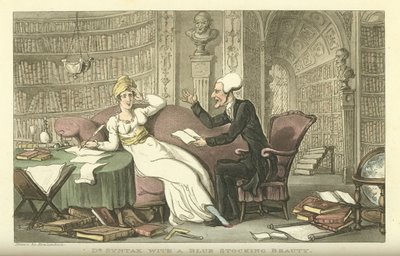Holy Bluestockings, Batman
Wikipedia discusses the Bluestockings as a social and educational movement that came into being in England in the mid-18th century in imitation of a similar, more formal movement in France.
Reinventing the Feminine: Bluestocking Women Writers in 18th Century London examines the context for the social salon's development in 18th century London, the major players in the literary revolution, and examples of written works that sustained the movement from 1750 to 1790.
The Concise Cambridge History of English Literature, 3rd edition, says this:
"During the first half of the 18th century, English women had little education and even less intellectual status. The first attempt to create a circle in which intelligent conversation should take the place of cards or scandalous chatter was made by Mrs. Elizabeth Vesey (1715-91), in whose literary gatherings the term "blue stocking" gained currency. Benjamin Stillingfleet... though gifted and brilliant, was not, in appearance at least, respectable. Being invited by Mrs. Vesey to one of her "conversations," he excused himself as sartorially unfit. Upon which the lady exclaimed: "Don't mind the dress; come in your blue stockings" --i.e. in blue or grey worsted, the everyday wear, instead of black silk, the correct wear for assemblies. "Bluestocking" or "undress" parties became a kind of catchword, and gradually, in the ironic course of time, the phrase applied to a man became applied to the women he met at these assemblies. Mrs. Vesey originated the blue-stocking circles, but the "Queen of the Blues" was Mrs. Elizabeth Montagu...
The blue-stockings were sometimes ridiculous, but they must not be dismissed as unimportant. They did much to infuse a general interest in literature and they helped to make society more decent."
 "Doctor Syntax with a Blue Stocking Beauty" by Thomas Rowlandson (1756–1827), from William Combe's The Third Tour of Doctor Syntax, In Search of a Wife, 1812.
"Doctor Syntax with a Blue Stocking Beauty" by Thomas Rowlandson (1756–1827), from William Combe's The Third Tour of Doctor Syntax, In Search of a Wife, 1812. "Breaking Up of the Blue Stocking Club," Thomas Rowlandson, 1815.
"Breaking Up of the Blue Stocking Club," Thomas Rowlandson, 1815.
Rowlandson’s print reminds us that the newer image of women as passive “angels of the house” was not the only one carrying cultural currency; older images of women who were raucous and ready for a fight were still funny to audiences in 1815. The melee he depicts, however, in which bluestockings—a semi-contemptuous term for learned women —fight like fishwives and spill “French cream” (shorthand for their supposed interest in the French Revolution), is a far cry from the decorous bluestocking teas that Hannah More had attended decades earlier.

3 Comments:
Hmm, for some reason I thought the bluestocking stuff happened later than this, but we are reaching into the early 19th century now, aren't we?
Kirstie posted a cool site about bluestocking culture in the 18th century(oh no, I almost said "bluestocking stuffers," it's the christmas bug!) earlier in the term...
Thanks for the link, I'll put it on my page! The Wikipedia article isn't all that good... maybe in another lifetime I'll edit it.
Good lord, the Wikipedia page is dreadful! Glad you reminded us of Kirsten's link, Marplot; that site is well done.
Love the images.
Post a Comment
<< Home